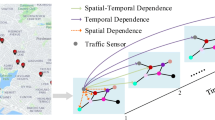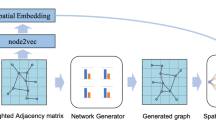Abstract
Traffic flow forecasting (TFF) is crucial for effective urban planning and traffic management. Most modeling approaches in TFF ignore the dynamic characteristics of the transportation network topology, which results in an inability to accurately capture the hidden spatiotemporal correlations. To this end, we investigate a Spatiotemporal Synchronous Dynamic Graph Attention Network (STS-DGAT) for TFF. STS-DGAT is composed of three parts: the dynamic feature enhancement (DFE) module, the spatiotemporal coupling (STC) module, and the temporal position embedding (TPE) module. Specifically, we discover the impact of traffic data features on TFF based on the DFE module, assign dynamic weights of various features for time steps, and adjust the intrinsic relevance of traffic data. Then, we propose the STC module to characterize the complex coupling relationships of road network nodes in spatial and temporal dimensions and the dynamic intrinsic interactions of spatiotemporal correlations. The STC module comprises a dynamic graph attention network (DGAT) and an adaptive gated temporal convolutional network (AGTCN). Deep characterization for the dynamic topology of road networks is mined by DGAT, which captures real-time dynamic spatial correlations, and hidden features in the nonlinear temporal dimension are extracted by AGTCN to learn long-term temporal dependency. Finally, we put forward a TPE module to incorporate temporal position information into spatiotemporal relationships and adaptively learn hidden features of individual nodes to understand spatiotemporal variation features effectively. Experimental results from four real-world datasets demonstrate that the STS-DGAT model outperforms other baseline models.












Similar content being viewed by others
Data availability
The datasets generated during and analyzed during the current study are available from the corresponding author on reasonable request.
References
Nagy AM, Simon V (2018) Survey on traffic prediction in smart cities. Pervasive Mob Comput 50:148–163
Vlahogianni EI, Karlaftis MG, Golias JC (2014) Short-term traffic forecasting: where we are and where we’re going. Transp Res Part C Emerg Technol 43:3–19
Xia D, Yang N, Jiang S, Hu Y, Li Y, Li H, Wang L (2022) A parallel NAW-DBLSTM algorithm on Spark for traffic flow forecasting. Neural Comput Appl 34:1557–1575
Wang C, Giannotti F, Cao L (2021) Learning complex couplings and interactions. IEEE Intell Syst 36:3–5
Xia D, Shen B, Geng J, Hu Y, Li Y, Li H (2023) Attention-based spatial-temporal adaptive dual-graph convolutional network for traffic flow forecasting. Neural Comput Appl 35:17217–17231
Zhu W, Sun Y, Yi X, Wang Y, Liu Z (2023) A correlation information-based spatiotemporal network for traffic flow forecasting. Neural Comput Appl 35:21181–21199
Ye Q, Szeto WY, Wong SC (2012) Short-term traffic speed forecasting based on data recorded at irregular intervals. IEEE Trans Intell Transp Syst 13:1727–1737
Liu J, Guan W (2004) A summary of traffic flow forecasting methods. J Highw Transp Res Dev 21:82–85
Williams BM, Hoel LA (2003) Modeling and forecasting vehicular traffic flow as a seasonal ARIMA process: theoretical basis and empirical results. J Transp Eng 129:664–672
Zivot E, Wang J (2006) Vector autoregressive models for multivariate time series. In: Modeling financial time series with S-PLUS®, pp 385–429
Van Houdt G, Mosquera C, Nápoles G (2020) A review on the long short-term memory model. Artif Intell Rev 53:5929–5955
Fu R, Zhang Z, Li L (2016) Using LSTM and GRU neural network methods for traffic flow prediction. In: 31st youth academic annual conference of Chinese association of automation (YAC). IEEE, pp 324–328
Zhao L, Song Y, Zhang C, Liu Y, Wang P, Lin T, Deng M, Li H (2019) T-GCN: a temporal graph convolutional network for traffic prediction. IEEE Trans Intell Transp Syst 21:3848–3858
Li Y, Yu R, Shahabi C, Liu Y (2017) Diffusion convolutional recurrent neural network: data-driven traffic forecasting. In: International conference on learning representations, pp 768–786
Wu Z, Pan S, Long G, Jiang J, Zhang C (2017) Graph wavenet for deep spatial-temporal graph modeling. In: International joint conference on artificial intelligence, pp 1907–1913
Huang J, Luo K, Cao L, Wen Y, Zhong S (2022) Learning multiaspect traffic couplings by multirelational graph attention networks for traffic prediction. IEEE Trans Intell Transp Syst 23:20681–20695
Li M, Zhu Z (2021) Spatial-temporal fusion graph neural networks for traffic flow forecasting. In: Proceedings of the AAAI conference on artificial intelligence, vol 35, pp 4189–4196
Zhao J, Liu Z, Sun Q, Li Q, Jia X, Zhang R (2022) Attention-based dynamic spatial-temporal graph convolutional networks for traffic speed forecasting. Expert Syst Appl 204:117511
Xia D, Zhang M, Yan X, Bai Y, Zheng Y, Li Y, Li H (2021) A distributed WND-LSTM model on MapReduce for short-term traffic flow prediction. Neural Comput Appl 33:2393–2410
Chen J, Li D, Zhang G, Zhang X (2018) Localized space-time autoregressive parameters estimation for traffic flow prediction in urban road networks. Appl Sci 8:277
Lippi M, Bertini M, Frasconi P (2013) Short-term traffic flow forecasting: an experimental comparison of time-series analysis and supervised learning. IEEE Trans Intell Transp Syst 14:871–882
Rabiner LR (1989) A tutorial on hidden Markov models and selected applications in speech recognition. Proc IEEE 77:257–286
Sun S, Zhang C, Yu G (2006) A Bayesian network approach to traffic flow forecasting. IEEE Trans Intell Transp Syst 7:124–132
Drucker H, Burges CJ, Kaufman L, Smola A, Vapnik V (1996) Support vector regression machines. Adv Neural Inf Process Syst 9:155–161
Zheng Z, Su D (2014) Short-term traffic volume forecasting: a k-nearest neighbor approach enhanced by constrained linearly sewing principle component algorithm. Transp Res Part C Emerg Technol 43:143–157
Liu Q, Wang B, Zhu Y (2018) Short-term traffic speed forecasting based on attention convolutional neural network for arterials. Comput Aided Civ Infrastruct Eng 33:999–1016
Wu Z, Pan S, Chen F, Long G, Zhang C, Philip SY (2020) A comprehensive survey on graph neural networks. IEEE Trans Neural Netw Learn Syst 32:4–24
Jiang W, Luo J (2022) Graph neural network for traffic forecasting: a survey. Expert Syst Appl 207:117921
Song C, Lin Y, Guo S, Wan H (2020) Spatial-temporal synchronous graph convolutional networks: A new framework for spatial-temporal network data forecasting. In: Proceedings of the AAAI conference on artificial intelligence, vol 34, pp 914–921
Yu B, Yin H, Zhu Z (2017) Spatio-temporal graph convolutional networks: a deep learning framework for traffic forecasting. In: International joint conference on artificial intelligence, pp 3634–3640
Guo K, Hu Y, Qian Z, Sun Y, Gao J, Yin B (2020) Dynamic graph convolution network for traffic forecasting based on latent network of Laplace matrix estimation. IEEE Trans Intell Transp Syst 23:1009–1018
Li F, Feng J, Yan H, Jin G, Yang F, Sun F, Jin D, Li Y (2023) Dynamic graph convolutional recurrent network for traffic prediction: benchmark and solution. ACM Trans Knowl Discov Data 17:1–21
Cheng W, Shen Y, Zhu Y, Huang L (2018) A neural attention model for urban air quality inference: learning the weights of monitoring stations. In: Proceedings of the AAAI conference on artificial intelligence, vol 32
Vaswani A, Shazeer N, Parmar N, Uszkoreit J, Jones L, Gomez AN, Kaiser Ł, Polosukhin I (2017) Attention is all you need. Adv Neural Inf Process Syst 30:5998–6008
Guo S, Lin Y, Feng N, Song C, Wan H (2019) Attention based spatial-temporal graph convolutional networks for traffic flow forecasting. In: Proceedings of the AAAI conference on artificial intelligence, vol 33, pp 922–929
Chen W, Chen L, Xie Y, Cao W, Gao Y, Feng X (2020) Multi-range attentive bicomponent graph convolutional network for traffic forecasting. In: Proceedings of the AAAI conference on artificial intelligence, vol 34, pp 3529–3536
Ye J, Zhao J, Ye K, Xu C (2020) How to build a graph-based deep learning architecture in traffic domain: a survey. IEEE Trans Intell Transp Syst 23:3904–3924
Zheng C, Fan X, Wang C, Qi J (2020) GMAN: a graph multi-attention network for traffic prediction. In: Proceedings of the AAAI conference on artificial intelligence, vol 34, pp 1234–1241
Guo S, Lin Y, Wan H, Li X, Cong G (2021) Learning dynamics and heterogeneity of spatial-temporal graph data for traffic forecasting. IEEE Trans Knowl Data Eng 34:5415–5428
Bai L, Yao L, Li C, Wang X, Wang C (2020) Adaptive graph convolutional recurrent network for traffic forecasting. Adv Neural Inf Process Syst 33:17804–17815
Han L, Du B, Sun L, Fu Y, Lv Y, Xiong H (2021) Dynamic and multi-faceted spatio-temporal deep learning for traffic speed forecasting. In: Proceedings of the 27th ACM SIGKDD conference on knowledge discovery & data mining, pp 547–555
Luo G, Zhang H, Yuan Q, Li J, Wang F-Y (2022) ESTNet: embedded spatial-temporal network for modeling traffic flow dynamics. IEEE Trans Intell Transp Syst 23:19201–19212
He K, Zhang X, Ren S, Sun J (2016) Deep residual learning for image recognition. In: Proceedings of the IEEE conference on computer vision and pattern recognition, pp 770–778
Woo S, Park J, Lee J-Y, Kweon IS (2018) CBAM: convolutional block attention module. In: Proceedings of the European conference on computer vision (ECCV), pp 3–19
Kong X, Zhou W, Shen G, Zhang W, Liu N, Yang Y (2023) Dynamic graph convolutional recurrent imputation network for spatiotemporal traffic missing data. Knowl-Based Syst 261:110188
Church KW (2017) Word2vec. Nat Lang Eng 23:155–162
Choi J, Choi H, Hwang J, Park N (2022) Graph neural controlled differential equations for traffic forecasting. In: Proceedings of the AAAI conference on artificial intelligence, vol 36, pp 6367–6374
Lan S, Ma Y, Huang W, Wang W, Yang H, Li P (2022) Dstagnn: dynamic spatial-temporal aware graph neural network for traffic flow forecasting. In: International conference on machine learning. PMLR, pp 11906–11917
Ketkar N, Moolayil J, Ketkar N, Moolayil J (2021) Introduction to Pytorch, deep learning with Python: learn best practices of deep learning models with PyTorch, pp 27–91
Huber PJ (1992) Robust estimation of a location parameter. In: Kotz S, Johnson NL (eds) 1992 breakthroughs in statistics: methodology and distribution. Springer, pp 492–518
Acknowledgements
This work described in this paper was supported in part by the National Natural Science Foundation of China (Grant nos. 62162012, 62173278, 62072061, and 62341115), the High-Level Innovative Talent Project of Guizhou Province (Grant no. QKHPTRC-GCC2023027), the Natural Science Research Project of Department of Education of Guizhou Province (Grant nos. QJJ2022015, QJJ2022047, QJJ2023012, and QJJ2023061), the Scientific Research Platform Project of Guizhou Minzu University (Grant no. GZMUSYS202104), and the Natural Science Foundation of Guizhou Minzu University (Grant no. GZMUZK2022YB19).
Author information
Authors and Affiliations
Corresponding author
Ethics declarations
Conflict of interest
The authors declare that there are no conflicts of interest regarding the publication of this paper.
Additional information
Publisher's Note
Springer Nature remains neutral with regard to jurisdictional claims in published maps and institutional affiliations.
Rights and permissions
Springer Nature or its licensor (e.g. a society or other partner) holds exclusive rights to this article under a publishing agreement with the author(s) or other rightsholder(s); author self-archiving of the accepted manuscript version of this article is solely governed by the terms of such publishing agreement and applicable law.
About this article
Cite this article
Xia, D., Lin, Z., Chen, Y. et al. Spatiotemporal synchronous dynamic graph attention network for traffic flow forecasting. Neural Comput & Applic (2024). https://doi.org/10.1007/s00521-024-09675-1
Received:
Accepted:
Published:
DOI: https://doi.org/10.1007/s00521-024-09675-1




